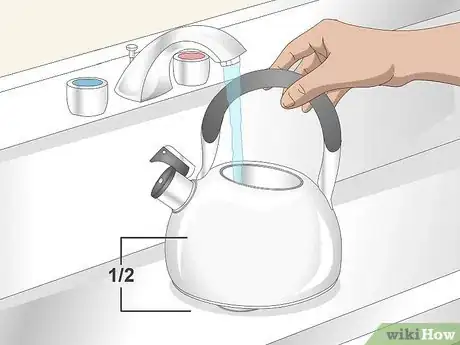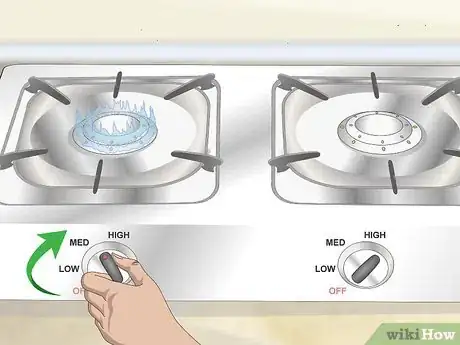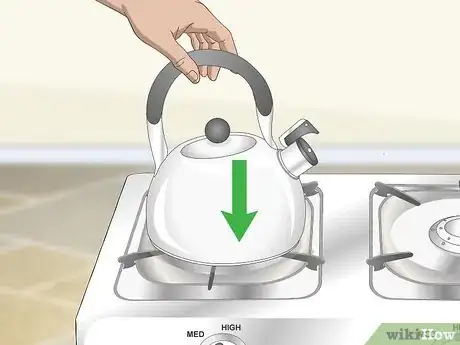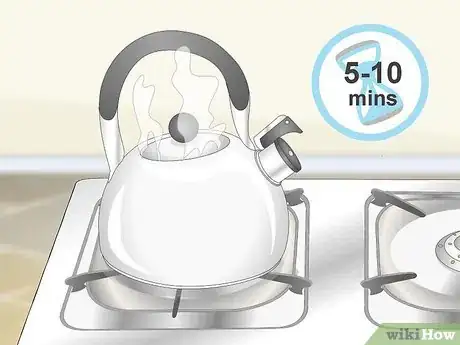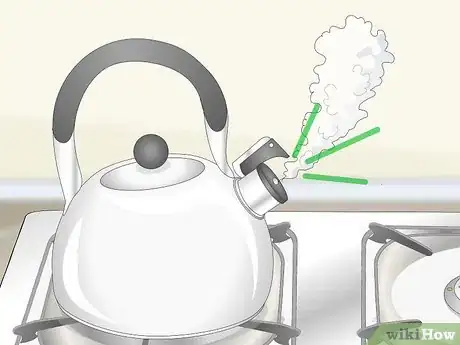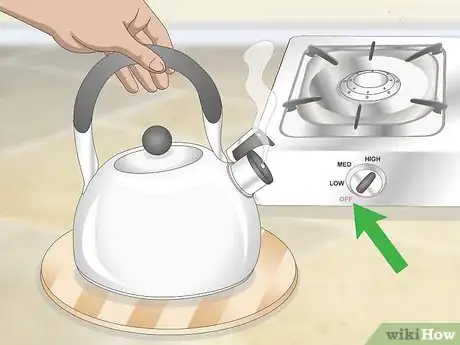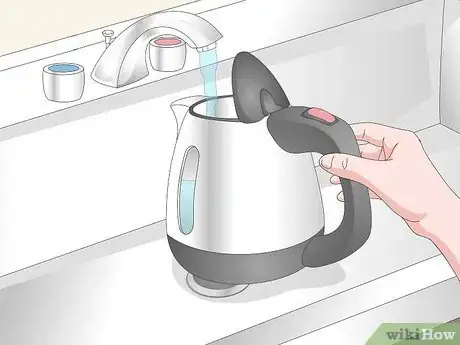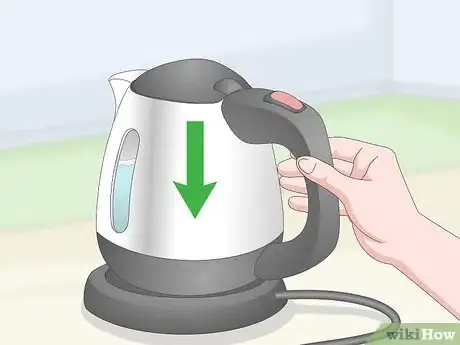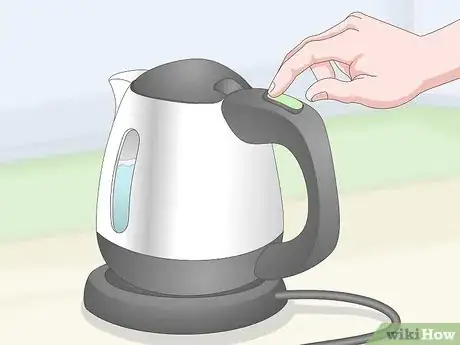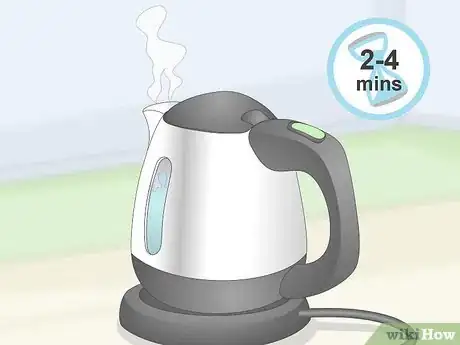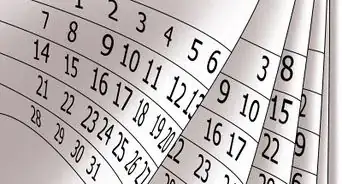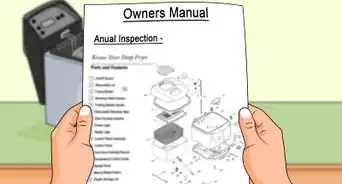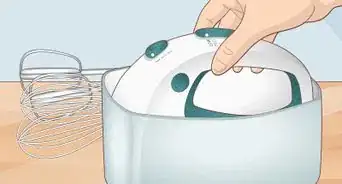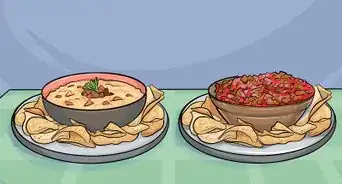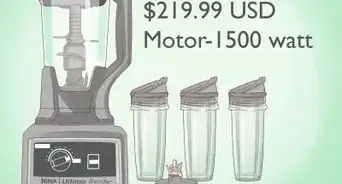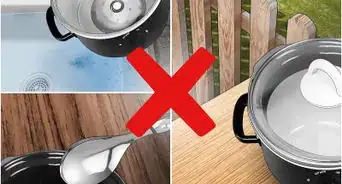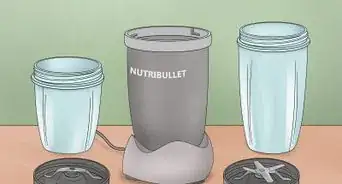This article was co-authored by wikiHow Staff. Our trained team of editors and researchers validate articles for accuracy and comprehensiveness. wikiHow's Content Management Team carefully monitors the work from our editorial staff to ensure that each article is backed by trusted research and meets our high quality standards.
There are 8 references cited in this article, which can be found at the bottom of the page.
This article has been viewed 96,410 times.
Learn more...
If you own a kettle, you can have boiling water for tea, coffee, or other items ready in a matter of minutes. It’s as easy as filling it up, placing it on the stove over medium-high heat, and waiting for it to begin steaming. Using an electric kettle is even simpler, as it allows you to walk away and focus on other things without worrying about your water boiling over.
Steps
Boiling Water on the Stove
-
1Fill your kettle at least halfway up with water. Remove the lid from the top of your kettle and hold it under a flowing faucet for a few seconds. If you want to speed things along, use hot water and let the tap run for a few moments before filling the kettle so that you’re starting with water that’s already warm.[1]
- Boiling water in a kettle that’s less than half full can be bad for it. If it overheats, it could burn, warp, or even melt.
-
2Turn on one burner of your stove to medium-high heat. Using a setting that’s hot (but not too hot) will help bring your water to a boil in less time without placing undue stress on your kettle. If your stove has burners of different sizes, select one of the larger ones. That way, the heat will be spread out evenly over a greater area.[2]
- If you’re timing your water with other food or beverage items, it’s okay to use a slightly lower heat setting (around medium). Keep in mind, however, that it may not ever boil if the temperature is too low.
Advertisement -
3Place the kettle on the cooktop. Set the kettle directly in the center of the preheated burner. From here, all you have to do is sit back and let the stove take care of the rest![3]
- Be sure to put the lid back on the kettle. Otherwise, it will take longer to heat up.
- If you’re using a gas cooktop, adjust the flames until they’re concentrated under the bottom of the kettle rather than letting them overlap the sides. If they climb too high, they could damage or discolor to the handle or lid.
-
4Heat the water for 5-10 minutes, or until it starts to bubble constantly. Water boils at 195–220 °F (91–104 °C). The amount of time it takes your kettle to reach this temperature may vary slightly, depending on how full it is. Afterwards, it will be extremely hot. Avoid touching any part except the handle.[4]
- It’s hard to predict exactly how long a certain amount of water will take to boil, so keep a close eye on the kettle the entire time it’s on the stove.
Safety Warning
Never leave a boiling kettle unattended. Doing so could increase the risk of fire or other accidents.
-
5Listen for your water to boil if you’re using a whistling kettle. Whistling kettles are fitted with a small device that emits a high-pitched sound when steam escapes from the spout. These types of kettles can be useful if you’re a multi-tasker or tend to be forgetful, as they’ll alert you when your water is ready.[5]
- Even if you’re using a whistling kettle, it’s a good idea to stick close so you can turn off the heat as soon as your water begins to boil.
-
6Turn off the stove and set the kettle on a heat-resistant surface to cool. Once your water has come to a boil, shut off the cooktop completely. Then, remove the kettle from the hot burner and place it on one of the unused cooking surfaces. Wait until the bubbling has died down to pour up your water.[6]
- To prevent burns, use a potholder to grip the handle of the kettle.
- Keep your hands and face away from the spout when you begin pouring. Steam can also cause burns, if you’re not careful.[7]
Using an Electric Kettle
-
1Fill your electric kettle with water. Open the hinged lid and run water into the kettle until it’s at least halfway full—under- or overfilling it could damage it or present a possible safety hazard. If there’s a fill line indicated somewhere on your kettle, make sure the water doesn’t sit higher than this point.[8]
- Most electric kettles are made to hold up to about 1.7 litres (57 fl oz) of water.[9]
- You can buy an electric kettle from any home goods store. Like all appliances, they range in price, but it’s not uncommon to find basic models for less than $30.
-
2Set the kettle on its base. Lower the kettle down into position so that the bottom rests securely over the center prong. You may hear a faint clicking sound once it’s seated properly.[10]
- Make sure the kettle is plugged into the nearest wall outlet.
- Before turning on your kettle, it’s a good idea to remove any objects in the immediate vicinity that could be damaged by heat.
-
3Flip the power switch on the backside of the kettle to the “On” position. On most models, the power switch will be located on or near the handle. Once you hit this switch, a small light will appear on the base to indicate that the kettle is plugged in and active.[11]
- If you want to turn the kettle off at any point, you can do so by flipping the power switch to the “Off” position.
-
4Allow 2-4 minutes for the water to begin boiling. Due to their highly-efficient design, electric kettles heat up in about half the time that it takes ordinary stovetop kettles. They’re also programmed to switch off automatically once they reach their targeted temperature, which means you’re free to do other things while your water heats up.[12]
- For your own safety, avoid touching any part of the kettle while it’s in use.
Tip
The speed and convenience offered by electric kettles makes them ideal for brewing coffee or tea or preparing water for thawing, poaching, blanching, and other cooking methods.[13]
-
5Handle the kettle with caution while it’s hot. Lift the kettle by its handle and use your other hand to steady it as you pour. Once you have as much water as you need, return the kettle to its base and take a moment to confirm that the light is off.[14]
- Don’t forget to refill your kettle before using it again.
Community Q&A
-
QuestionWhen is the water in a kettle boiled?
 AasimTop AnswererIf using a stovetop kettle, you will know when the water reaches boiling if you hear whistling coming out of the spout. If using an electric kettle, you will know when the water reaches boiling when it shuts off.
AasimTop AnswererIf using a stovetop kettle, you will know when the water reaches boiling if you hear whistling coming out of the spout. If using an electric kettle, you will know when the water reaches boiling when it shuts off. -
QuestionWhat happens if I overfill or underfill the kettle?
 AasimTop AnswererIf you overfill the kettle, then there will not be enough room for the steam to escape. If you underfill the kettle, then it will boil dry, potentially creating a fire hazard or permanently damaging the kettle. For this reason, many electric kettles come with an automatic shutoff to prevent this from happening.
AasimTop AnswererIf you overfill the kettle, then there will not be enough room for the steam to escape. If you underfill the kettle, then it will boil dry, potentially creating a fire hazard or permanently damaging the kettle. For this reason, many electric kettles come with an automatic shutoff to prevent this from happening. -
QuestionDo electric kettles beep or whistle to let you know they are boiling?
 AasimTop AnswererElectric kettles have an automatic shutoff that activates when the water reaches boiling. This is present to reduce the risk of fire. Even if the kettle does boil dry, it will still shut off to avoid causing a fire.
AasimTop AnswererElectric kettles have an automatic shutoff that activates when the water reaches boiling. This is present to reduce the risk of fire. Even if the kettle does boil dry, it will still shut off to avoid causing a fire.
Warnings
- If you have small children at home, make sure you keep hot kettles situated out of grabbing distance.⧼thumbs_response⧽
Things You’ll Need
- Stovetop or electric kettle
- Water
- Potholder
References
- ↑ https://producthelp.kitchenaid.com/Countertop_Appliances/Kitchenware/Non_Electric_Kettles/Non_Electric_Kettle_Tips
- ↑ https://whatkettle.com/how-to-boil-water-in-a-kettle/
- ↑ https://whatkettle.com/how-to-boil-water-in-a-kettle/
- ↑ https://www.seriouseats.com/2010/08/how-to-boil-water-faster-simmer-temperatures.html
- ↑ https://www.youtube.com/watch?v=eVl37RoL_8Y&feature=youtu.be&t=30
- ↑ https://producthelp.kitchenaid.com/Countertop_Appliances/Kitchenware/Non_Electric_Kettles/Non_Electric_Kettle_Tips
- ↑ https://www.goodhousekeeping.com/institute/a20619/tea-kettle-safety/
- ↑ https://www.epicurious.com/expert-advice/why-you-need-an-electric-kettle-article
- ↑ https://www.businessinsider.com/best-kettle-electric-tea
- ↑ https://whatkettle.com/how-to-boil-water-in-a-kettle/
- ↑ https://whatkettle.com/how-to-boil-water-in-a-kettle/
- ↑ https://www.explainthatstuff.com/how-electric-kettles-work.html
- ↑ https://www.epicurious.com/expert-advice/why-you-need-an-electric-kettle-article
- ↑ https://whatkettle.com/how-to-boil-water-in-a-kettle/
About This Article
Boiling water in a kettle is fairly simple if you have a stovetop. First, remove the top of your kettle and fill it about halfway with tap water. Turn your burner on to medium-high heat, then place the kettle on the stove. It usually takes 5-10 minutes for the water to boil. You’ll know it’s boiling when the tea kettle starts to whistle, which is caused by steam exiting the small hole in the spout. Once it’s boiling, turn the stove off and set the kettle on a heat-resistant surface so it can cool. To learn how to use an electric kettle, read on!
